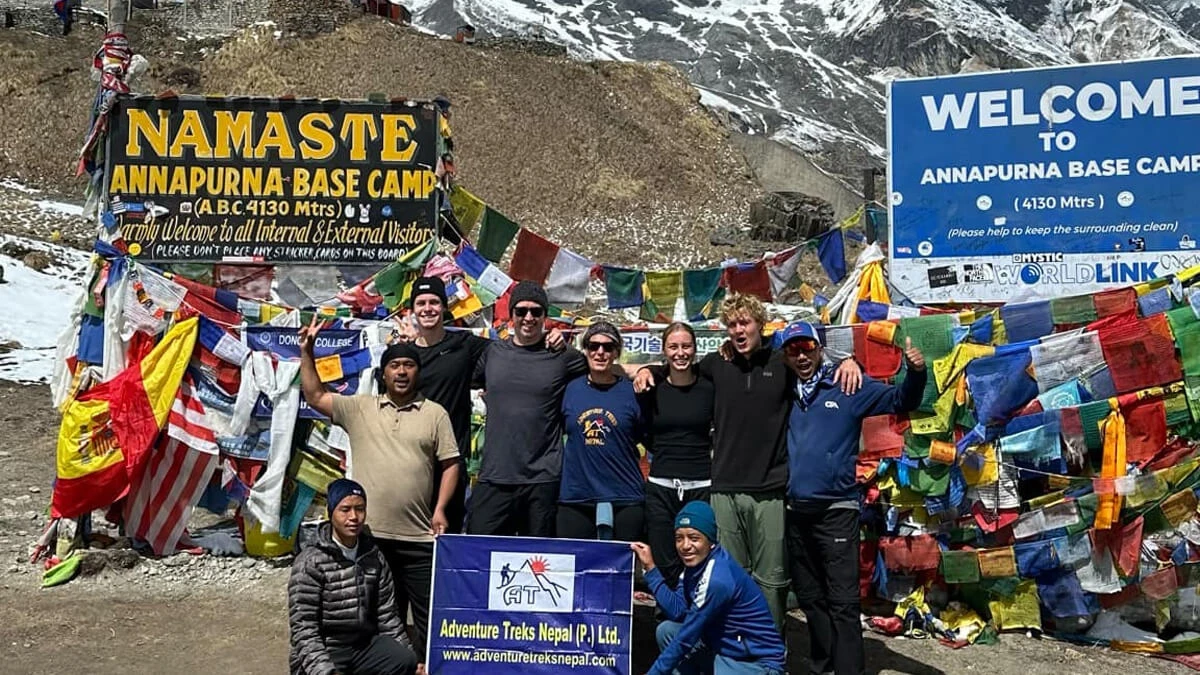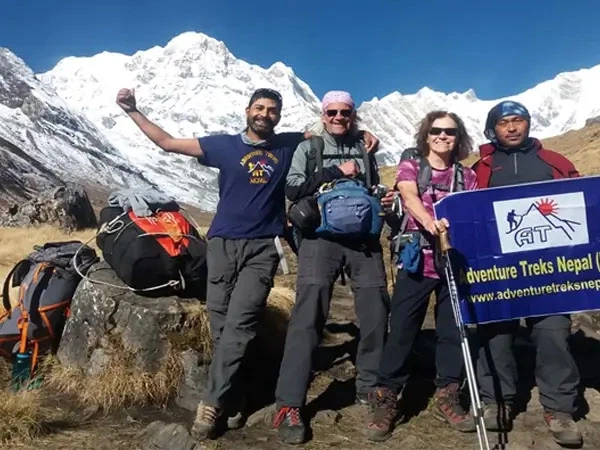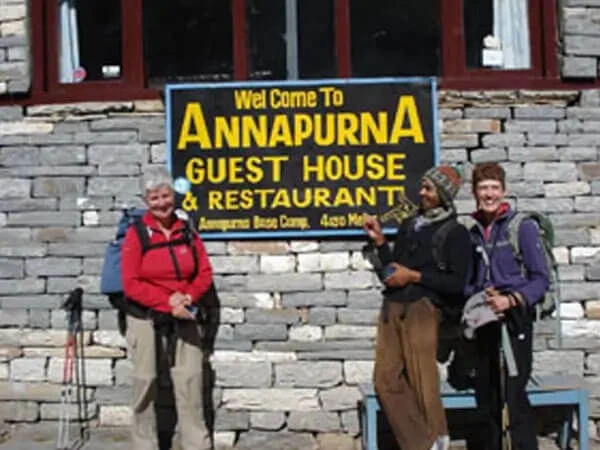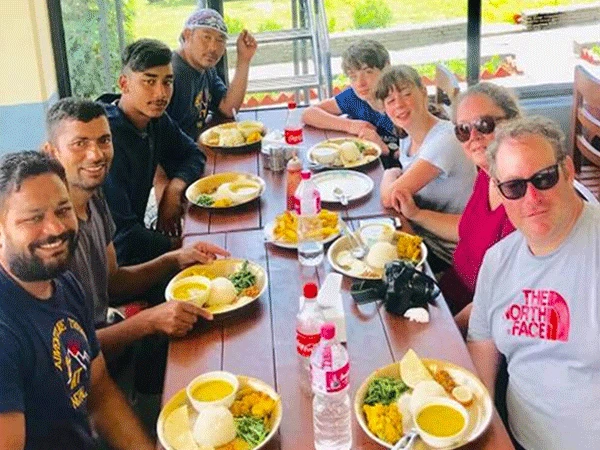Why choose the Annapurna Base Camp Trek in 2026?
Navigating the trails to Annapurna Base Camp is easier-going and less strenuous, though it offers comparable experiences to Everest Base Camp (5364 m). Accordingly, the journey also offers you the best cultural encounters since several settlements along the ABC route have comfortable teahouses and homestay services. While staying in such a family-friendly environment, you can learn about local cultures through their traditional welcome, warm hospitality, and interactions with them, facilitated by a guide.
Trekkers spot various rare animals during the walk through the Annapurna Conservation Area, the biggest one among conservation areas, with an area of 7629 square kilometers, spreading across Kaski, Lamjung, Manang, Mustang, and Myagdi. Generally, you can capture activities of wildlife, including musk deer, langur monkeys, leopards, goral, kalij pheasants, Himalayan monal, and snow pheasant in their natural surroundings.
Since the Annapurna Base Camp initial point is easily accessible from Pokhara by road ride and doable within a week to two weeks, the journey has become several trekkers’ bucket-list trip. The adventure is not only about exploration of pristine wilderness and reaching the foothills of the the tenth-highest mountain on our planet, but also a golden opportunity to discover ancient monasteries and gompas, adorned with small chortens and prayer wheels.
Observation of the daily life of locals and monks in religious sites will allow you to have deep insight into centuries-old traditions, especially those influenced by Tibetan Buddhism. Therefore, this trip can be the most wonderful choice for a beginner and adventure seeker to complete their trek without more physical and mental strain.

Why is the Annapurna Base Camp Trek Guide essential?
Depending on the tourism rules and regulations of Nepal, you cannot trek to any trekking spots in Nepal without a licensed guide, including the Annapurna Base Camp route. Although a guide assists you in managing all logistics for the journey, a comprehensive guide will give you a deep insight into itineraries, routes, costs, entry permits, accommodations, and preparation tips to make your journey manageable.
While looking over previous records, trekkers with no proper guide have faced many critical conditions due to lack of topographical structure, alternative ways, and exact weather of places while trekking to different regions, including beginner-friendly Annapurna and Langtang. With the purpose of helping you in preparing for the Annapurna Base Camp, we have included everything you need to know before venturing into the trek.
Follow the instructions as given in the Annapurna Base Camp Trek guide to make your journey successful with the great budget plan, well-structured itinerary, and reliable logistics by ensuring your health, safety, and enjoyment in 2025/2027.
What Are the Main Routes for the Annapurna Base Camp Trek?
As per trekkers’ choices, there are several routes to the Annapurna Base Camp to relish the charm of the Annapurna region. Each will offer you a unique experience, unlike other more difficult and off-the-beaten-path ones like Kanchenjunga. Choose the best for you depending on your vacation period and physical fitness, estimating cost and ensuring joy on the trek. Generally, Annapurna Base Camp packages have a short version via Ghandruk after Nayapul, a classic route including a side trip to Ghorepani Poon Hill, and a longer version by combining the ABC route with the Annapurna Circuit or Mardi Himal trail.
How should the Annapurna Base Camp Trekking itinerary be?
Before venturing on the journey, it is crucial to ensure that the selected schedule of the journey suits your preferences and fitness level. The Annapurna Base Camp Trek itinerary guide encourages you to choose the package that includes proper acclimatization. Even though most stays will be in lower elevations, we usually suggest that you pause in settlements like Chhomrong (2170 m) and Deruali (3230 m) before heading to spend a night under the blanket of sparkling stars at Annapurna Base Camp.
If you have a short vacation, choose the one that gets activated from Pokhara and takes you as high as possible by 4WD to begin official trekking. We have Annapurna Base Camp Trekking from Pokhara - 8 days with similar experiences to the longer version for those who want to complete the journey sooner. Ensure that your daily trekking distance and the total hiking length are appropriate within a suitable duration. However, you can customize itineraries based on your choices while choosing us for your guiding team.
We have the following packages with smooth itineraries to reach the Annapurna Base Camp.
Who Can do the Annapurna Base Camp Trekking?
Among several Himalayan trekking paths in the heart of the Annapurna ranges, the Annapurna Base Camp trek is one that is a moderate-level journey, suitable for a child to an elderly member of the family. Like the Ghorepani Poon Hill Trek, Mardi Himal Trek, Langtang Valley Trek, and Everest Panorama Trek, this trek is also achievable while following the comprehensive guide for trekking Annapurna Base Camp.
You need to be self-assured at first, even if you lack experience in high-elevation terrains or physical fitness. If you get involved in simple cardiovascular exercises and yoga practice for two or three months before the itinerary starts, you can complete this exhilarating journey easily.
When should you embark on Annapurna Trekking for a successful journey?
Trekking in Nepal's Himalayan terrain requires careful planning. To minimize unforeseen situations on the treks, the majority of locations, including the Annapurna Base Camp Trekking, are accessible throughout the year. Generally, spring (March to May) and autumn (September to November) are the best times to trek to any destination due to unique features, pleasant weather, moderate temperature, and suitability for walking.
While off-seasons present more risks due to floods, landslides, and avalanches while walking, these trekking months of blooming flowers and crystal-clear skies also prevent the potential hazards of getting injured. Even though the walk only reaches 4130 meters, the bitter cold makes winter trekking to Annapurna Base Camp quite difficult. Most of Nepal has significant rainfall during the monsoon, which blocks important hiking routes. In order to prevent your entire trip from being ruined, we advise avoiding the Annapurna Trek and other excursions during the winter and monsoon seasons.
Do you need an Annapurna Base Camp Map for the trek?
Since you are unfamiliar with the new places in the Annapurna region, having a map that includes various villages, major highlights, rest stops, mountain ranges, and elevation profiles is essential for making your journey manageable. The Annapurna Base Camp Trek guide also suggests you carry a direction compass, which helps you in recognizing the accurate turn according to the map at the time of confusion, especially when more than two trails appear.
To avoid harsh situations because of getting lost, learn the main trails, sub-paths, and other alternative trails, although a guide accompanies you, as unpredicted circumstances never come by alerting you. Concerning trekkers’ safety, Adventure Treks Nepal’s Annapurna Base Camp Trekking package also includes a map for each individual.
What permits does the Annapurna Base Camp Trekking require?
Obtaining entry permits to trek to various trekking areas in Nepal is compulsion-based on the government’s rules and regulations of tourism with the concerns for its sustainability and hikers’ security. Must-have permits are a TIMs (Trekkers Information Management System) card and an Annapurna Conservation Area Permit, which are easily achievable either at Pokhara or at Kathmandu through the Nepal Tourism Board. Nevertheless, you do not have to worry about these kinds of paperwork, as the trekking and travel agencies begin to process them on your behalf before you arrive in Nepal.
Since you must verify all necessary documents at various checkpoints such as Birethanti, do not try to break the rules, leading to paying for penalties or other punishments according to Nepal’s law. Do not think that permits are only a process to enter the region for trekking because the administration keeps every trekker’s information together with the detailed itinerary to track you until the journey is complete.
Where to stay for safety on the route to Annapurna Base Camp?
After walking for hours, covering approximately 5 to 9 kilometers, you need comfortable accommodation at the end of each day to save yourself from severe cold, chilly winds and wild animals. Except during the off-seasons (Monsoon and winter), most teahouses will be serving tourists like you, providing great hospitality and fresh meals. While staying at homestays and teahouses, you will get a common room with a shared bed, simple furniture, a blanket, and shared bathrooms. However, we can attempt to provide you a private room on your special request with an extra cost.
Adjusting to such simple lodges and foods will be unfamiliar to you, but the breathtaking environment around you makes you joyful even in the absence of facilities like hot showers. private washrooms and varieties of foods (Western and Tibetan). Except in some large settlements, you will get “Dal and Bhat,” which includes steamed rice, lentil soup, pickled tomato, and seasonal vegetables. However, meat items, noodles, and pancakes are also available in some restaurants, which might be quite costly.
How to stay healthier and safer during the Annapurna Base Camp trekking?
Health and Safety is always the first priority on the Himalayan adventure because only a trekker with a sound body and mind can complete this journey wisely. To keep yourself far from getting injuries, you should walk carefully with the proper equipment. Do not separate from your team and a guide, as you might get lost in unfamiliar places. Take with you contact numbers of fellow trekkers and local administrations. In case you need support or rescue, you can easily contact them.
However, keep in mind that the network is weak in the high-elevation terrains of the Annapurna region. The comprehensive guide for Annapurna trekking also suggests you not feel isolated when you are far from your family and loved ones without conversations for a few days for mental health. Sometimes the feeling of missing advanced facilities will lead to going back home without completing the journey. Therefore, keep yourself busy in savoring the beauty of nature and sharing experiences with your fellows.
A trekker may feel symptoms of acute high sickness above 2500 m, leading to critical health issues. Accordingly, listen to your body and inform your guide to prevent such problems as well as descend to a lower altitude. Avoid drinking alcohol and smoking, as they will increase the chance of high-altitude-related problems in places with lower-level oxygen. Drinking water is crucial to keep yourself hydrated, but do not use direct water from different sources, including rivers, streams, waterfalls, and taps.
While drinking water without using a purification tablet or boiling it, you may suffer from diarrhea or other health issues. Weakness will not let you traverse some difficult sections and will ruin your journey. Therefore, we suggest you also considerpersonal hygiene and nutritious food throughout the entire journey.
How difficult is the Annapurna Base Camp Trek?
Regarding trekking difficulties, the Annapurna Base Camp trek is among the greatest moderate treks in the Annapurna region. With the correct equipment and planning, anyone, regardless of age, can reach the foothills of Mount Annapurna. However, over 2,500 meters, trekkers should be ready to face erratic weather and difficulties associated with high altitude. On a 14-day trek, there may be challenges due to steep ascents and descents, glacial moraines, and certain landslide-prone places.
Deurali (3200 m) is a high-altitude village that offers safe and comfortable lodging before you get at the Annapurna Base Camp. It may contain a few teahouses with basic amenities. A beginner or experienced hiker may encounter challenging conditions due to the thin air and frigid temperatures on higher terrain. To prevent both physical and emotional exhaustion, our schedule is customized for each person, irrespective of age and level of fitness.
Why do you need to hire a guide and a porter to trek to the Annapurna Base Camp Trek?
Hiring a guide is required in order to secure trekking permits for any hiking site in Nepal. This allows you to safely navigate trails and see the rich cultural riches, customs, and lives of ethnic groups including the Gurung, Magar, and Thakali. Adventure Treks Nepal's skilled hiking guides speak English well and are conversant in regional dialects. Because they may share the untold tales and insights they discover from different communities, you will thus be familiar with the history of locations, old gompas and monasteries, and regional customs.
Even if you have a map, only a knowledgeable guide is aware of alternate routes in the event that construction or natural calamities like floods render the main trail impassable. Your trip will be remembered if you hire a guide and a porter. The guide will ensure your safety and assist you during jungle activities in Chitwan National Park, while the local porter will allow you to walk freely by carrying your bulky trekking bags and other hike necessities.
How much does Annapurna Base Camp trekking cost?
The cost of the Annapurna Base Camp Trek depends on a number of variables, such as the route, season, accommodations, food, facilities, a guide, porter service, trekking distance, and length of the trek. The total cost may be less because a hiker can simply take a 4WD to the starting location instead of taking a domestic aircraft.
Adventure Treks does not include international airfare, travel insurance, Nepal entrance visa, additional food and dessert, city meals, porter and driver tips, sleeping bags, or a down jacket. Trekking permits and other logistics are included in the price of Nepal's 14-day ABC trip. Because there is a greater demand for guides, porters, food, and teahouses during the busiest times of the year (spring and autumn), the cost of the journey may be higher than during off-peak times.
Prebooking is therefore essential during certain months to guarantee your logistics. When costs in some rural areas are a little higher than average, you should respect the hard work of the inhabitants. Examine the Annapurna Base Camp Trekking package's elements in the Cost Details section below to plan your trip wisely and steer clear of unforeseen costs.

What essentials do you need to pack for Annapurna Base Camp Trekking?
Another component of the walk is strategic packing, which involves careful planning to eliminate extraneous goods that will simply make your backpack heavier. Packing wisely will ensure that you finish the trip without any further difficulties because the proper hiking requirements secure your safety when walking on mountainous terrain. The Annapurna Base Camp Trekking checklist for 2025 and 2026 is shown below to make packing easy for you:
Clothing
- Moisture-wicking base layers (Merino wool t-shirts or long-sleeve tops, synthetic polyester or nylon thermal tops, lightweight compression tops, and leggings)
- Insulating mid-layers (Fleece jackets or pullovers, down vests or jackets, synthetic insulated jackets)
- Waterproof outer layers (Waterproof hardshell jackets with breathable membranes (e.g., Gore-Tex), Waterproof pants or rain pants, Windproof rain shells)
Footwear
- Trekking boot with sturdy grip
- Socks (both thick woolen and thinner)
- Slippers/lightweight sandals
Trekking gear
- Trekking poles
- Sleeping bag
- Day backpack
- multi-tool or pocket knife,
- Rain cover for backpack
Health and Personal items
- Reusable water bottle
- Water purification tablet
- Insect repellent
- Sunscreen, Hats, and UV glasses
- First Aid Kit with medication related to acute mountain sickness, blisters, bandages, personal medicines, and painkillers.
- Biodegradable soap, wet wipes, hand sanitizer, and quick-dry towels
Travel documents and permits
- Valid passport
- Passport-size photos
- Travel Insurance
- Trekking permits (A TIM’s card, ACAP, and Chitwan National Park Entry Permit)
Others
- Headlamp with extra batteries
- Cameras and Binoculars
- Charger, power bank
- Journal, pen, and games

How to prepare for Annapurna Base Camp trekking?
Trekking with a guide and a strategy always goes more smoothly than trekking alone, as the latter can present risks and unneeded inconveniences. However, for the safety of trekkers, Nepal's trekking regulations prohibit any self-guided excursions. Despite the presence of a guide, you should psychologically and physically prepare for the challenging portions of the Annapurna routes, acclimate to the harsh terrain at high elevations, and balance the endurance needed for extended walking days.
To increase physical preparedness and guarantee more seamless performance in high-altitude mountainous terrains, participate in standard cardiovascular workouts like jogging, running, swimming, rowing, and walking in addition to going to neighboring hills or trails with an elevation of more than 2000 m. We advise doing yoga and meditation one month prior to the trip, as this promotes mental and emotional stability and physical strength while assisting in negotiating the challenging Annapurna region's paths during the 14-day Annapurna Base Camp Trekking.
Conclusion
To sum up, this Annapurna Base Camp Trek guide help to plan the trip effectively, even when you are worried about high acute sickness, weather, physical fitness, and mental resilience. Your decisions throughout your trip to any location in Nepal will not be influenced by our Adventure Treks Nepal team. Because you can shorten or lengthen the trip, you should tailor your plan to your preferences.
Since the length of the Annapurna Base Camp Trek varies from person to person due to a number of circumstances, you can choose to finish the itinerary in a week or go for a longer one that lasts two to three weeks and includes side trips and a variety of natural beauties.










